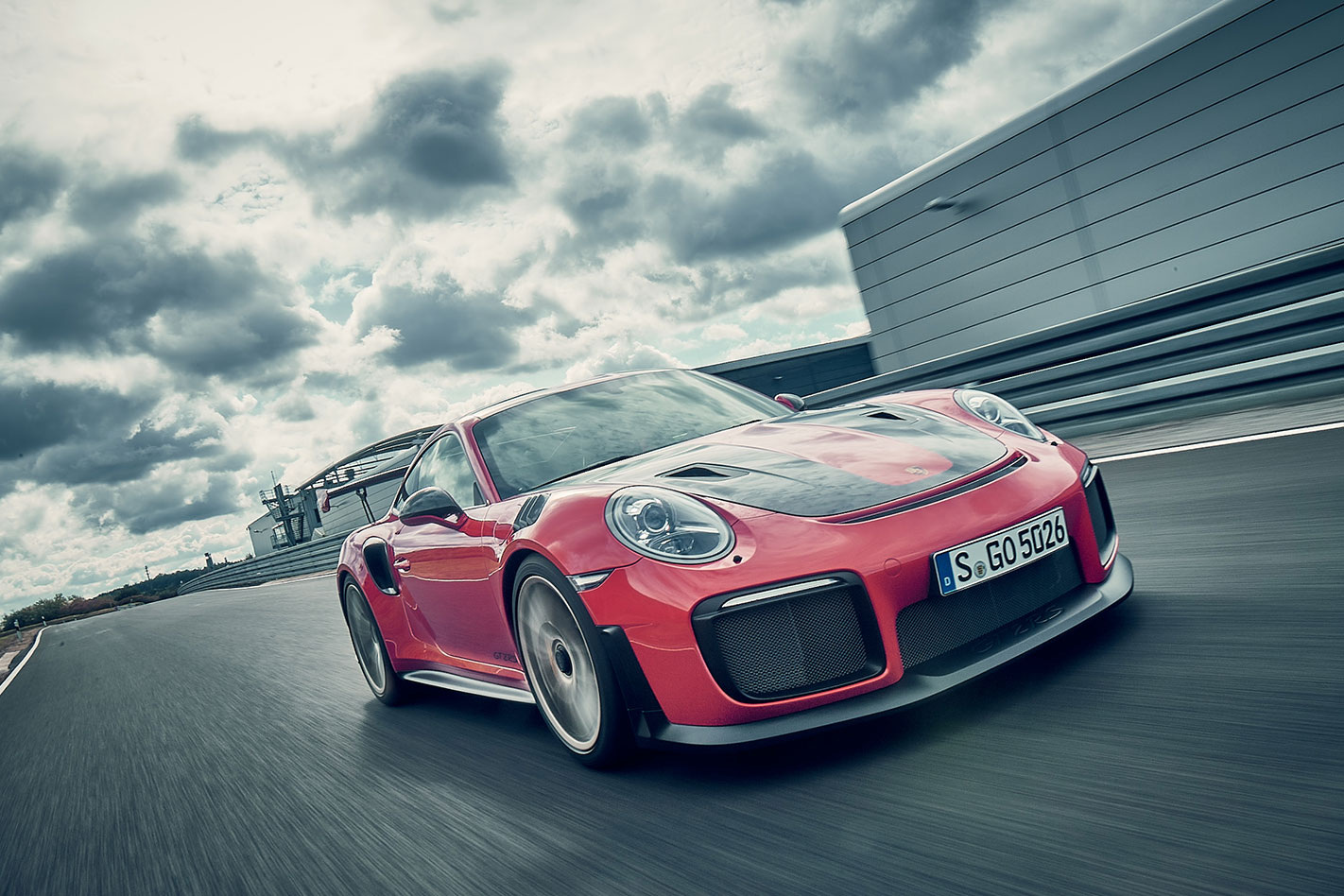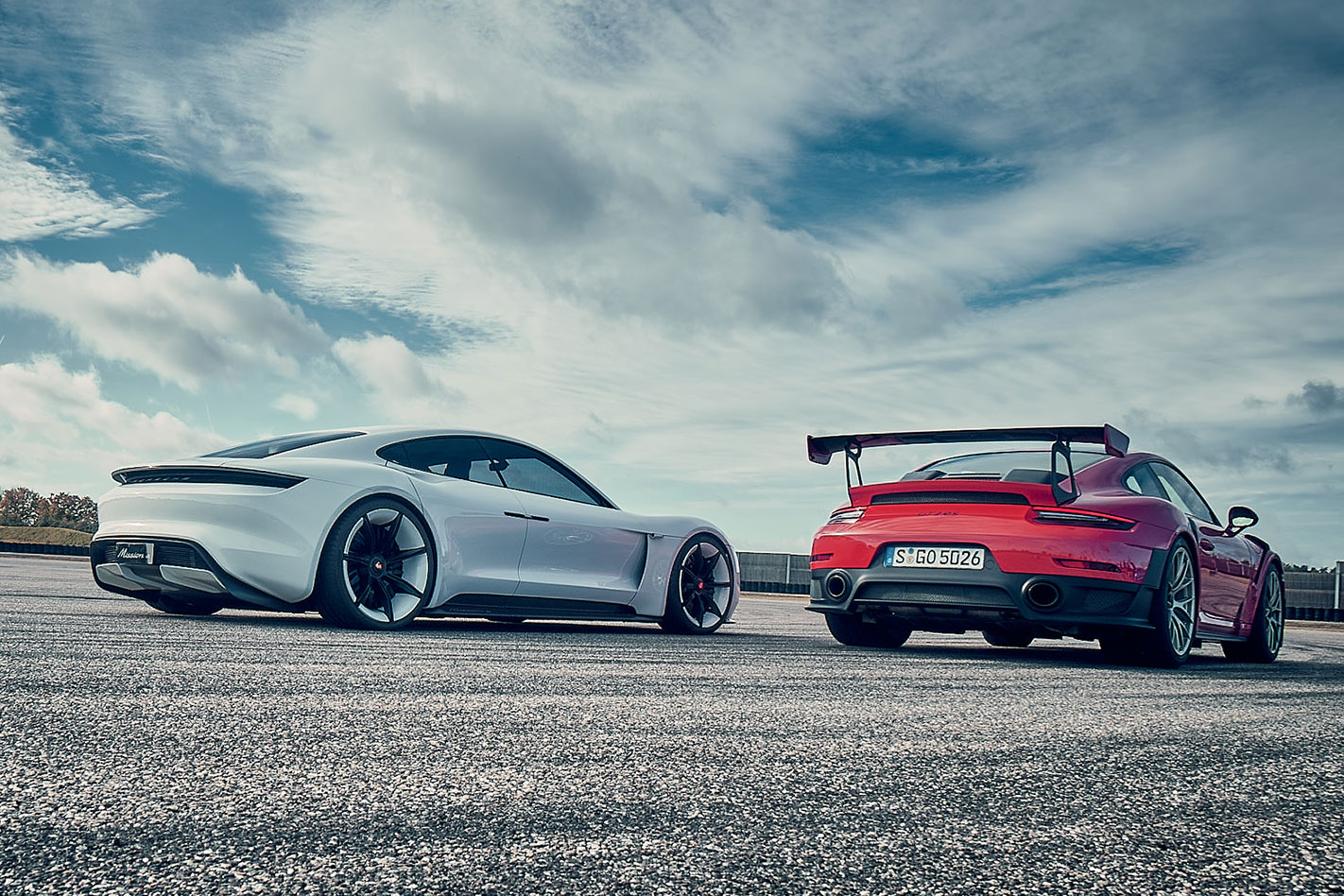There will never be another day like this – 2018 911 GT2 RS meets 2020 Mission E.
While the pair are polar opposites in character and content, their DNA is fused by the desire to deliver maximum driving pleasure. In a way, it’s volt versus octane – or, more broadly, present versus future. Except, this time at least, there is no loser and this isn’t specifically a comparison. Electric drive may one day replace the iconic petrol-fed flat six, but for the time being, the two propulsion ideals are going to live side by side, as demonstrated by the plug-in hybrid. So let’s bask in the glory of what we have now while exploring the future.
Like its predecessors, the latest top-notch RS sold out long before the order books opened. The red and black beast we have here, model number 001, is the rarest of a rare breed. The 515kW/750Nm weapon is equipped with the desirable Weissach Pack, which cuts 30kg, yet adds a hefty price premium. However, when playing in this league, buyers want the ultimate.


The Weissach research and development team are protecting their baby like a first born. To drive the Mission E, you actually need permission from the board of directors. You also need to be granted the goodwill of the specialised crew trained to deal with the bytes and bugs that tend to haunt such a one-off, high-voltage car. As we approach the object of desire on a Sunday morning in October, there is tension in the air, literally and figuratively speaking.

By definition and aesthetics, the GT2 RS is an entirely different kettle of fish. One look at the massive single-deck rear wing, the flared carbon-fibre sills and the protruding front splitter is all it takes to understand that this is definitely not a run-of-the-mill 911. It has presence in spades, but it’s functional, too. For example, that rear wing creates 340kg of downforce at maximum speed while, in Sport Plus, the two massive tailpipes emit a cacophony of sound and become virtual flame throwers. When viewed from behind at night the wide-body 911 looks like the devil’s very own chariot. All the louvres, ducts, splitters, aprons, skirts and air blades scattered around the muscular body manage to befriend the wind and placate the massive amount of heat emitted.

On the inside, the Mission E has electric doors, windows and seats, along with a high-tech cockpit featuring five animated round instruments and a centre stack featuring a giant touchscreen (think Tesla). The classy, all-black centre stack – non-functional at the time of our test – is seamless and curved, and conveniently arranged for sound ergonomics. The ambience is clearly more iPad generation, but the designers did also apply classic luxury traits, such as supple leather with matching wood and metal accents.


While the Mission E is undergoing final tests on its ECU by the men in Porsche coats, I take the chance to head out on track in the GT2 RS. The surface is still moist in some places and the marbles on both sides of the racing line shout caution. Taking it easy until the tyres get some temperature is definitely the right thing to do. It also gives me a chance to reacquaint myself with the Weissach track, which was built in 1972. Even the long variant is actually quite a short circuit with only thirteen corners, but because of the great variety of crests, climbs, descents and surface changes, the rollercoaster drive invariably gets the heart racing.

I’m familiar with all the numbers as I’ve been in this car before. And yet, flooring the loud pedal for the first time in the most powerful 911 is breathtaking. Managing the mighty forward thrust is a challenge for all the senses. Adding an extra dash of drama, every move the GT2 RS makes has its own tone of voice. It has quirks and idiosyncrasies aplenty.
The next thing your ears register is the difference between cold and hot tyres, brakes and engine. Early on in the game the tyres drum, the brakes chafe and the engine conveys quite a hoarse soundtrack. But this car isn’t about mere progress. Still, testing the mid-range waters by cornering at 70 per cent and braking a bit too early is a good idea at first. Once comfortable, the GT2 RS begs to be whipped hard. After all, its reason for existence is to be a showcase of the great work completed by the engineers, putting its performance curve above many foes by being the pinnacle of the Porsche crop. However, it’s time to experience the future – one that is beckoning whether we like it or not.

The plan from Germany is not only to make this a more committed and rewarding drive than the Tesla Model S, but to also warrant unconditional repeatability. And when you’ve got hypo cars in your portfolio such as the GT2 RS, the ‘future’ has to stack up to the present. However, to best the likes of Tesla, there needs to be some parameters the Mission E must meet in order for it to be deemed a success – both internally and in terms of sales. The batteries and motors must not heat excessively, the cell chemistry and single, highly complex cooling circuit must cope with recurrent, full-discharge cycles, and hour-long high-speed runs on the Autobahn must not eat the range in one fell swoop. Yet talk is cheap, a drive is in order to see what’s what.

“If you like our sports cars, you will love the way Mission E drives,” promises project leader, Stefan Weckbach. “After all, this is the Porsche among the BEVs. It totally complies with our philosophy, fusing intuitive controls with a rear-bias torque split for emotional dynamics. Add to this the lower centre of gravity and available features like rear-wheel steering and active anti-roll bars, and it should not be difficult to imagine the result.”

The GT2 RS boasts similar side-to-side traction along with rear-wheel steering, active dampers (PASM) and carbon-ceramic brakes. In fact, this is the first Porsche road-car engine equipped with water injection designed to cool off the heat exchangers. Whenever the intake air temperature exceeds 50 degrees and the driver buries the throttle to the firewall, the system (fed by a five-litre water tank) will kick in.

However, what makes the GT2 RS so very, very special is the force-fed powerhouse that lurks beneath the carbon-fibre lid, which also accommodates two gaping air intakes to feed the turbos and a tall double-decker rear wing. The new 3.8-litre engine delivers a monstrous 515kW at 7000rpm, eclipsing the previous 3.6-litre unit by 59kW. At the same time, peak torque increases from 700 to 750Nm, available from 2500rpm. There’s a real sweet spot at 4500rpm, resulting in phenomenal mid-range punch. Despite this, what bends the mind most is the acceleration in fourth and fifth gears, giving the GT2 RS an uncanny ability to outpace just about anything on the road as all hell breaks loose in the final 1200rpm from 6000rpm to cut-out. To get a feel for how explosive this narrow rpm bracket really is, check out the onboard video which captures the recent record lap on the Nürburgring.

Speaking of cost, it is worth noting that the Mission E is going to be priced between Cayenne and Panamera, and only slightly above the least expensive Tesla model S. While Porsche’s original goal was to build around 20,000 high-end BEVs per year, the unusually zealous marketing department has suggested that adding another 10,000 units to that tally is achievable.

If we’re being really honest, for most of us the 368kW GT3 would be more than enough, but, of course, there’s always the upcoming 991.2 GT3 RS, which promises to be more track focussed than the pricey 515kW all-rounder. Ultimately, the GT2 RS makes you recalibrate your inner speedometer. A judgement adjustment needs to be made regarding relative distances, braking markers and the limit of adhesion. The GT2 RS really does up the ante that much in all the aforementioned areas. On a good day in dry weather with little traffic you’ll be left in no doubt that this is the real McCoy. It is, currently, the 911.

It’s essential to keep a firm grip on the wheel because every ridge, painted kerb and expansion joint will want to make the GT2 RS rip its rear wing off. The biggest dare on this diminutive track is to keep the right hoof firmly planted from the exit of the last bend to the entry of the first right hander. Wide eyed, we briefly saw 270km/h before stomping on the anchors – hard. It’s enthralling and all a bit too much to take in for just one moment in time.

The Numbers – The Future and the Present

| u00a0 | PORSCHE 911 GT2 RS | PORSCHE MISSION E |
| BODY | 2-door, 2-seat coupe | 4-door, 4-seat coupe |
| DRIVE | rear-wheel | all-wheel |
| ENGINE | 3800cc flat-6, DOHC, 24v twin-turbo | Permanent magnet synchronous |
| BORE/STROKE | 102.0 x 77.5mm | N/A |
| COMPRESSION | 9.0:1 | N/A |
| POWER | 515kW @ 7000rpm | 300-500kW |
| TORQUE | 750Nm @ 2500-4500rpm | 850Nm |
| POWER/WEIGHT | 350kW/tonne | 136-227kW/tonne |
| TRANSMISSION | 7-speed dual-clutch | 2-speed |
| WEIGHT | 1470kg | 2200kg |
| SUSPENSION (F) | double A-arms, adaptive dampers, anti-roll bar | double A-arms, adaptive dampers, active anti-roll bar |
| SUSPENSION (R) | multi-links, adaptive dampers, anti-roll bar | multi-links, adaptive dampers, active anti-roll bar |
| L/W/H | 4549/1880/1297mm | 4850/1990/1300mm |
| WHEELBASE | 2453mm | N/A |
| TRACKS | 1588/1557mm (f/r) | N/A |
| STEERING | electrically assisted rack-and-pinion, four-wheel steer | electrically assisted rack-and-pinion, four-wheel steer |
| BRAKES (F) | 410mm carbon-ceramic discs, 6-piston calipers | N/A |
| BRAKES (R) | 390mm carbon-ceramic discs, 4-piston calipers | N/A |
| WHEELS | 20.0 x 9.5-inch; 21.0 x 12.5-inch (f/r) | 21.0 x 8.5-inch (f); 22.0 x 10.0-inch (r) |
| TYRE SIZES | 265/35 ZR20 (f); 325/30 ZR21 (r) | 245/35 ZR21 (f); 285/30 ZR22 (r) |
| TYRE | Pirelli P Zero | Pirelli P Zero |
| PRICE AS TESTED | $645,400 | $200-400,000 (est.) |
| LIKES | Torque-laden grunt; razor-sharp handling; u2019Ring-smashing pace | An unwavering commitment to driver enjoyment; charging time |
| DISLIKES | Allocations are all accounted for; Itu2019s not exactly cheap u2013 if you can get one | No noise; weu2019ll have to see if Porsche can deliver electric-only thrills |
| RATING | 5 out of 5 stars | TBC |





